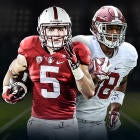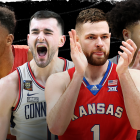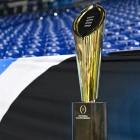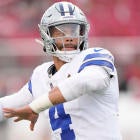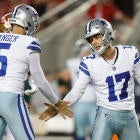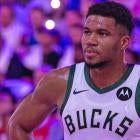A college football offense can take many forms. We're going to do our best to find the best one.
If college football could have an elite offense -- a truly unstoppable force of top-tier players working simultaneously -- what would it look like? Would it feature All-Americans from left to right? Or would it be more about fit in a specific system? The best balance, as is often the case, lies somewhere in the middle.
This is the team we've attempted to create with our ideal offense for the 2016 college football season. (An ideal defense will be coming next week.)
Methodology: Before we get started, let's lay out a couple of ground rules -- which are more of what you'd call guidelines than actual rules.
First, choices were made largely based on fit. In other words, a player considered to be among the best at his position wasn't necessarily selected. This isn't an All-Conference or All-America team based on production, though as you will find, some names inevitably overlap. It's also not a requirement for a selection to have played in the offense we're running.
A player's would-be role on the team was taken into consideration. For example, there are three wide receivers on our ideal offense. It wouldn't make a lot of sense to have three big-bodied No. 1s all running deep routes as their strength. We want role players, not five players of the same skill set.
With those things in mind, here's our ideal offense for the 2016 college football season, from scheme to play-caller to the players themselves.
Scheme: Spread -- No need to overthink it. There are countless different types of playbooks and accompanying verbiage that stem from a handful of schemes, but put simply, the spread offense is a popular choice in college football. It puts dynamic playmakers in open spaces and usually features a dual-threat quarterback, which is almost a must-have in today's game.
Offensive coordinator: Kendal Briles, Baylor -- This is going to ignite some blowback. I understand and accept it. There's no sugar coating it: The Briles name is toxic because of the university's sexual assault scandal. Based on Baylor's Findings of Fact from consultant Pepper Hamilton alone, an entire house cleaning of the coaching staff, which would include Kendal Briles, is a legitimate demand regardless of the offseason timetable.
However, the younger Briles isn't explicitly named in the summary. And if we're just focusing Xs and Os acumen, Briles is one of the brightest young minds in the college game. In his first year as offensive coordinator in 2015, Briles helped lead the Bears to the No. 1 scoring offense in college football (48.1 points per game). As the passing game coordinator from 2012-14, Briles coached up the Bears' air attack to a top-five finish each season.
It'll be interesting for a variety of reasons to see how Briles does this year without his father, former head coach Art Briles, on the sidelines. However, the younger Briles has shown an ability to adapt play-calling and scheme based on personnel, the most extreme example being Baylor's shift to a modified single-wing offense in the absence of a quarterback. In the Russell Athletic Bowl against North Carolina, Baylor put up 645 rushing yards. If a spread offense is your scheme of choice, Briles is an exceptional mind to run it.
Honorable mentions: Lincoln Riley, Lane Kiffin
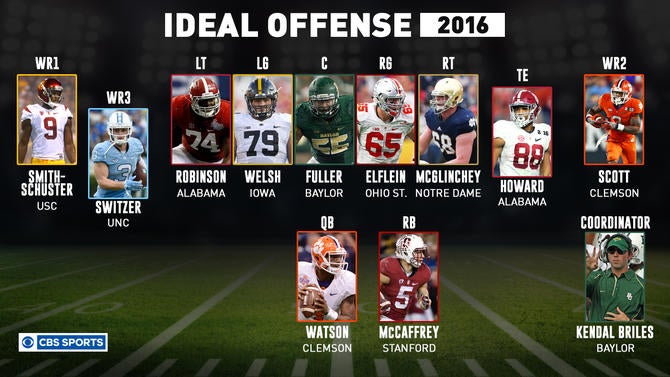
Quarterback: Deshaun Watson, Clemson -- Watson ranked atop our hypothetical 'NCAA Football 17' ratings and is a preseason frontrunner for every applicable individual award. I'm all for going off the beaten path when it comes these selections, but some things are just too obvious. Watson is the perfect fit for our ideal spread offense. He can run, he can throw, he is the most complete quarterback in college football and could very well be a No. 1 overall selection in the 2017 draft. He has improved accuracy, an excellent arm and good mobility. There's nothing else for which you can ask. Honorable mentions: Baker Mayfield, JT Barrett, Patrick Mahomes
Running back: Christian McCaffrey, Stanford -- There are better true running backs returning this year, but none are more versatile than McCaffrey. He plays in Stanford's power offense, but his quick twitch, unreal burst and breakaway speed makes him perfect for our spread. Seriously, imagine him in the same backfield as Watson on a zone-read play. As a bonus, Briles can line McCaffrey out wide and the Stanford standout has the football smarts to be as good a route runner as any other receiver on the field. You can even use McCaffrey as a passer on a trick play. Honorable mentions: Dalvin Cook, Sony Michel, Shock Linwood
Wide receiver (1): Juju Smith-Schuster, USC -- It was easy to get tunnel vision on skill players who fit the traditional spread mold (i.e., smaller, explosive players with sick juke moves). But I also knew I wanted at least one bigger wideout who was a true vertical and red zone threat. Watson has a big arm and good enough touch on passes that he can utilize a weapon like that.
Enter Smith-Schuster. He could be the first wideout taken in next year's draft. At 6-foot-2 and 215 pounds, he has the size, catch radius and jump ball capability of a prototypical No. 1 pass-catcher. However, he doesn't sacrifice speed and forces defenses to honor the long ball. Honorable mention: Mike Williams, Calvin Ridley, Jehu Chesson, Corey Davis
Wide receiver (2): Artavis Scott, Clemson -- This was the single most difficult choice to make. Ridley is a legit No. 1 option who could also act as a a complementary receiver because of his ability to take short passes and pick up chunk yards after the catch. Ultimately, though, Ridley and Smith-Schuster are true deep threats, and I didn't want to minimize Ridley's game to just one aspect.
So we've arrived at Scott. He's a burner, too, but I like his skill set -- specifically, his wiggle -- in the short-to-intermediate passing attack the best. If defenses have to respect Smith-Schuster's as a vertical threat, Scott can do a lot of damage in underneath routes. Honorable mention: Calvin Ridley, James Washington, Gabe Marks
Wide receiver (3): Ryan Switzer, North Carolina -- A shifty slot guy completes this potent wide receiver corps. Deciding between Switzer and Texas A&M's Christian Kirk was difficult, as both are difficult players to defend in the open field, but I like Switzer's consistency a little bit more. That comes with being in the game longer. Switzer and McCaffrey could double as return men, so versatility is a plus as well. Swtizer's reliability and make-you-miss skill set serves a perfect rounding out piece for this unit. Honorable mention: Christian Kirk
Tight end: O.J. Howard, Alabama -- Mismatch, mismatch, mismatch. That's the only way to describe Howard as a player. The national championship game against Clemson (208 yards, two touchdowns) was Howard's breakout performance -- the validation, finally, of what he could be as receiving weapon. Split him out and watch him feast against linebackers or nickel guys who are either too slow or too small to effectively cover him. Choosing Howard is still a bit of a risk -- he hasn't proven consistently he can be a threat in the passing game -- but the measurables are off the charts. Honorable mention: Pharaoh Brown, Jake Butt
Left tackle: Cam Robinson, Alabama -- Robinson is pure, raw power at left tackle. There's a real case to be made he's the best player on Alabama's roster. When it comes to protecting the blind side, there's no cutting corners. Robinson is the guy who's going to keep Watson's jersey clean while allowing this spread to rack up major yardage. Honorable mention: Mitch Hyatt, Roderick Johnson
Left guard: Sean Welsh, Iowa -- Like Elfein, Welsh is experienced and tough as nails. For as much speed as I want to put on the field, there's something satisfying about an interior of an offensive line that's going to bully the hell out of the defense in the trenches. I want tough, hard run blocking and the Fuller-Elfein-Welsh trio gets it done when it's late in the fourth quarter. Honorable mention: Tyrone Crowder, Braden Smith
Center: Kyle Fuller, Baylor -- The center, not the quarterback, can be the smartest guy on the field. They are, after all, the ones calling out blocking assignments. Who better to run Briles' offense than the one who already does? Fuller has the smarts, the experience and the athleticism to make our ideal spread offense go before the ball has ever been snapped. Honorable mention: Jay Guillermo, Tyler Orlosky
Right guard: Pat Elfein, Ohio State -- Elfein is versatile enough to play guard and center, but with Fuller in the middle of the line, we're keeping the senior Buckeye at guard. He's tough, reliable and a vicious run blocker. That's going to bode well for McCaffrey when he does run north and south between the tackles. After all, who says a spread offense has to lack physicality? Honorable mention: Quenton Nelson, Tyrone Crowder
Right tackle: Mike McGlinchey, Notre Dame -- It was tempting to move Roderick Johnson to right tackle just so I could have him in the lineup, but rules (guidelines) are rules (guidelines), and Johnson is an excellent left tackle. I'm keeping McGlinchey at right tackle even though he's bound to move to the left side of the line. What stands out most about McGlinchey is he's a nice, long player who has a wide base. He's not the athlete Ronnie Stanley was, but he was a big reason why an injury-riddled Notre Dame offense continued to be potent. Honorable mention: John Heck, Dan Skipper







